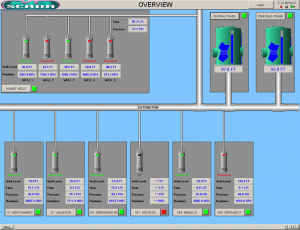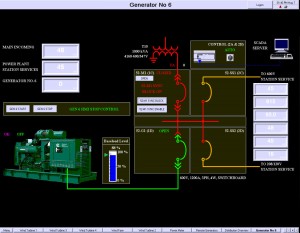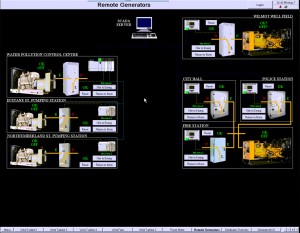A PEI utility brings the benefits of SCADA to water, wastewater, wind turbines, and backup generators.
For over a decade, utilities have turned to supervisory control and data acquisition (SCADA) systems to monitor and control their remote infrastructure. Originally, SCADA systems simply eliminated the need for personnel to visit remote sites in order to manually operate equipment and record levels.
Over time, the perceived value of SCADA began to shift. Users focused more on using tools like trends and reports to mine historical data to discover issues and opportunities for efficiency. In this article, operators and integrators for the City of Summerside, PEI, discuss how they applied the benefits of SCADA to their emergency generators, wastewater treatment plant, potable water system, and wind turbine farm.
The Wastewater System
They selected VTScada software from Trihedral. “We have two workstations here at the plant and five operators that view it through the internet. They can make changes in certain parts. Other things can only be changed by me or an administrator.” Bill Robinson from CBCL installed the original software application. “Since then, we have added a few details here and there ourselves. It’s been a great program. We’ve had no problems with it. It’s user friendly if you are at all familiar with computers.”Frank Murphy is the Waste Water Treatment Supervisor at the city’s wastewater department. “In 2008, we built a new wastewater treatment plant,” says Murphy. “We had no [SCADA] system before that. We needed to put something in place to control all of our pumps and equipment. If there were problems, we needed to be able to look at the process locally or from home so we can correct or at least diagnose them.”

The Water System
Sam Arsenault is an Assistant Supervisor with the city. In 2010, his department also adopted VTScada when they upgraded the city’s potable water system. “We thought we would stick with what we knew since it had worked well on the wastewater side,” says Arsenault. Jody Gallant is a Project Manager at Shadcomm Limited, the New Brunswick-based integrator that performed the upgrade. “Since we began using VTScada three years ago, it has become our preferred solution for all SCADA projects. Its ease of use, reliability, and functionality make it second to none in the industry.”
The water system consists of two reservoirs (standpipes) and a total of eleven wells located throughout the city. The reservoirs act in parallel to provide continuous fire storage capacity, as well as the ability to service each reservoir without shutting down the system. The new SCADA application replaced antiquated RTU’s with Ethernet-enabled RTU’s in CSA certified control cabinets tied together with a new wireless Ethernet network. This allowed the system to be integrated into the city’s existing IT infrastructure and made it available for an eventual “Smart Grid” integration to Summerside’s Power Utility.
The VTScada application was installed at the main IT server room, which provided access to stable power, and backup facilities. Operator and supervisor access to the system was achieved using the software’s Internet Client capabilities which allowed access to authorized users from anywhere within and outside the city network.
“The objective was to allow us to start and stop submersible pumps at each of the wells and also log data from each well,” says Arsenault. VTScada’s ability to trend flows and well levels, allows operators to quickly spot problems with wells or pumps. Additionally, reporting and trending features help staff prepare monthly and annual reports more efficiently by reducing the need to enter data manually. “It also provided a much better database for us in terms of our water consumption,” says Arsenault. “Over the course of a year, we look at how much water we used each month. We can see which day was the peak and determine if we were able to meet that demand. This gives us an idea of when we need to add new wells into our system. In our case, it told us that we were in pretty good shape for the size of our customer base.“
“There are some built-in reporting features that I use quite often. I apply the Daily Total Reports to the flow meters. That gives me the total volume of water being supplied to our utility. We assume that this is equal to the consumption for that day because the change in the two water tower levels is pretty negligible from one day to another. It’s nice to be able to use VTScada to verify that. It’s also useful for troubleshooting when something is not functioning properly at one of the wells. Without leaving our office, VTScada allows us to do preliminary troubleshooting and diagnose which piece of equipment may be malfunctioning. That’s been one of the biggest values to us.”
The Wind Turbine Farm
The management of the system is also a key to its success. Shadcomm Ltd, the system integrator, maintains a close tie to the system for maintenance purposes. Although they are located two and a half hours from Summerside, they are able to use a remote connection to troubleshoot and modify the project as necessary. Additionally, they can easily distribute fixes and added features to utility staff using VTScada ChangeSet files.

Over the last decade, in an effort to reduce its energy footprint, Summerside has become a Canadian leader in the percentage of its electricity use provided by wind turbines. Jason Naugler, an Electrical Engineer at Strum Engineering, specializes in control and automation systems. “There are four wind turbines in their farm that tie into their electrical substation.” The SCADA system does not control the direction and blade pitch of the wind turbines. A proprietary control system handles this. VTScada interfaces with the control sys-tem to extract information such as wind speed and direction, circuit breaker status, and the amount of electricity each turbine generates. This is compiled in VTScada’s integrated historical database and displayed to operators on a series of graphic displays.
Paul Babin, a Mechanical Engineer with Strum Engineering, developed a separate application for the wind farm system’s substation. “This type of wind turbine requires a small amount of electricity in order to generate power. Voltage from the nearby substation excites the generators so that they can produce power when rotated by the wind,” says Babin. “Basically, we incorporated alarming, visual displays, and created graphics that allow operators to go in and see the status of the substation. We do trending and data logging so they can call up past history. We’ve used VTScada for a number of different wind farms in P.E.I and Nova Scotia. It’s very versatile and integrates a number of different communication protocols. In this case we were using DNP3 and Modbus.”
Emergency Generators
Naugler also adapted the wind turbine SCADA application to monitor and control the city’s black start generator at their power plant. “The utility primarily buys electricity from New Brunswick Power but in the event that a line goes down they currently have five (soon to be six) generators to provide start up and power generation for some of their more essential circuits in the city.” The plant includes several old ‘air start’ generators that that require tanks of compressed air to start. They only have enough air to attempt two starts on the smallest generator. That’s how my first project got motivated. They put in a battery start station service generator that is the first to start in a blackout condition. It effectively provides power for the compressor(s) so that it will be able to supply air to start their larger generators which feed the essential circuits in their city.

“In addition to the generators at the power plant, each pumping station located across the city has a generator with a transfer switch to provide power to that station in the event the utility loses service from New Brunswick Power,” says Naugler. “Another thing we did was to allow operators at the power plant to [remotely start] each generator to power that pumping station.” This frees the generators in the power plant from carrying the load of all the pumping stations in the event of a power failure.
The Value of SCADA
For over ten years, the City of Summerside has used SCADA to reduce their electrical footprint, reduce costs and improve service to their customers. Using a common SCADA software product across all their applications also provides numerous additional benefits such as a shared skill set for their staff and multiple avenues of support.
